Black-shingled shield - how to drive off a stinky bug
The superfamily bugs (Pentatomoidea) includes a large number of species of bugs that are harmful to agriculture. Phytophagous insects feed on the juice of berries, grains and vegetables, reducing yield and slowing plant development. The black-headed marshmallow at all stages of development harms legumes, beets, carrots, radishes, cabbage. In the autumn, bugs move to berry bushes - raspberries, currants. With a strong infection of plants, insecticides are used to destroy pests.

View description
Black-billed scutellaria (Carpocorispurpureipennis) belongs to the family of real scutelluses, the genus of carpocoris. The Latin name of the Pentatomidae family is derived from two words - pente (five), tomos (section). In bugs, the filiform tendrils consist of 5 segments, and the body of 5 main sections. The length of the insect is 10-14 mm. The head is triangular in shape, flat, partially retracted into the prothorax. The eyes are large, bulging. The antennae are filiform, four segments black, only the first red. The proboscis is adapted for piercing plant tissues and absorbing liquid food. It consists of four segments.
Massive shield wide at the shoulders and tapering at the back. The lateral parts are raised, the edges of the pronotum are almost straight. A wide abdominal rim protrudes from under the folded wings. The surface of the flap densely punctured by small dots. The leathery parts of the front wings are chitinized, the hind wings are well developed. The body color is variable, there are individuals of yellowish, violet, red-brown color. The corners of the flap are black. The limbs are orange, walking type, two claws on the foot.
Information. Outlets of the odorous bugs are represented by grooves.
Biology and Reproduction
The period of activity of insects is from May to September — October. Adults hibernate under the remains of foliage and other vegetation. In spring, they appear for additional nutrition and reproduction. Over a year, one generation of shield insects develops. Habitats: overgrown gardens, fields, vegetable gardens, roadsides and forest edges.
Interesting fact. Defending against an attack by enemies helps the defender to release an unpleasant, pungent odor. Because of this property, the popular name of the insect is the stink bug.
Breeding
The breeding season begins in May. At this time, insects are active, fly in search of a pair. Having found a female, the bugs mate. The process takes place anywhere, insects turn backwards to each other and close with the ends of the abdomen. A fertilized female makes masonry on fodder plants of the legume, cereal, aster and cruciferous families.
Eggs are attached to the inner surface of the sheet in heaps of 20-40 pieces. Sticky secretion secreted by the female helps them to stay in place. The shape of the eggs is cylindrical with a rounded base and a lid on top. At first, the masonry is creamy or greenish; as embryos develop, it becomes dark orange. The total fertility of the female is up to 100 eggs. She places the masonry in different places, flying between the leaves. After crawling out of the larvae, the shell remains in place, laid in even rows.
Embryo development takes 2-3 weeks. Hatching nymphs hold together for a while. They sit next to the masonry and bask in the sun.Having strengthened, the larvae creep along the plant. In insects with incomplete transformation, the offspring outwardly resembles adults. The shield of nymphs is variegated, the abdomen is light, round, covered with dark dots and stripes. Antennae black, composed of four segments. The larva passes 5 ages. By autumn, it turns into an imago.
Distribution area
Black-billed scutellaria is common throughout Europe and Central Asia. The habitat extends north to Finland and Sweden. Bed bugs are found in Turkey and East Asia (South Korea, Mongolia). In Russia, insects are noted in European regions.
Harmfulness of phytophage bugs
Black-headed scutellum in the beginning of summer damages legumes and cereals. Bed bugs polyphages feed on potatoes, cabbage, carrots, beet seeds. In August, young adults and larvae of the last age move to berry bushes, where they harm raspberries. Insect repels:
- planting of a tsififuga racemosa or black cohosh;
- mustard powder scattered in the aisle;
- processing plants with a decoction of onion peel (200 g of product in 5 l of water).
One way to get rid of pests is manual assembly. Bedbugs are harmless to humans, do not bite. At the time of danger, they release a liquid with an unpleasant odor, so it is necessary to work with gloves or shake shields in a jar. Collected insects are destroyed. With severe infection of the garden, insecticides “Karbofos” and “Chlorophos” are used.

